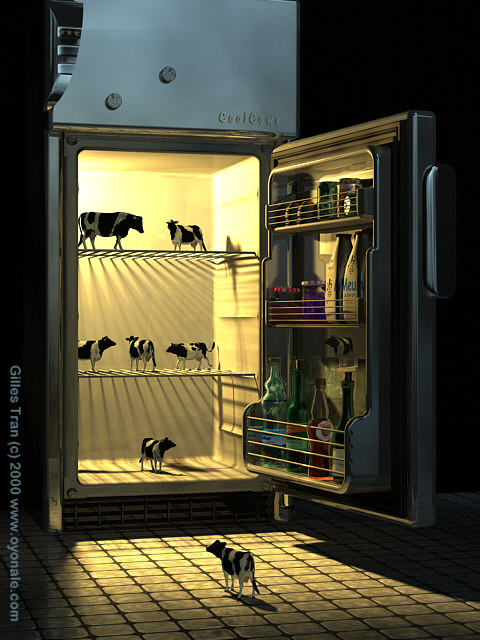





The day the cows took over, I was fortunately away, studying penguins in a faraway island that ruminants had never heard of. My colleagues were called back to fight in the name of civilisation, and I was left behind to take care of the buildings, with plenty of food, fuel and a little plane.
I followed the ensuing war on the radio. As it raged on, I listened day after day how mankind was defeated and taken into slavery. Then the stations went dead. They left the air in a tumult of shouts, banging of chairs, and bursts of automatic rifle fire. The peace of static came after a last roaring, victorious moo.
In the following years I searched the waves for the last traces of human freedom. The best I could pick up was music, from an orbital station that nobody had bothered to shoot down. The recorded voice who never tired of announcing oldies but goldies was my only link to the past. It slowly started to fade, however, as the station's batteries wore off, and one day even the Beatles were gone.
The penguins weren't much of a company, in spite of them wearing tuxedos. And there was little left that I didn't know about them. I was alone and I decided to go back. I had maintained the plane in good shape and there was enough kerosene to take me to the closest harbour town, or what was left of it, one thousand miles away. I packed my few belongings and took off.
I more or less knew what I would find. If you?ve read Animal Farm and Planet of the Apes (Clifford D. Simak's City is much too mild) , you already have an idea. Except that this time it was for real. In last months before the fall, chilling tales had been seeping through.
The cows did split up mankind in two halves, the meat people and the milk people. The meat people, mostly men, were castrated and sent to fattening camps. The milk people, mostly women, were artificially inseminated and kept in dairy compounds, where they were milked twice a day. There were few exceptions. Some humans were used as breeders and lasted a little longer. Others selected for their aggressive traits were hacked to pieces by the bravest bulls for the public enjoyment of cheering bovine crowds. Everyone else ended up in the slaughterhouse. What became of the meat and milk was unclear. When the first news of the system came in, the escapees who brought them didn't know much about what happened beyond their camp's limits. It was believed that the cows used the human products as wages for their auxiliaries, the dogs, cats, monkeys and pigs who did much of the dirty work. How the system had evolved by now, it was impossible for me to say.
The land below was beautiful, a rolling sea of grassy hills, punctuated by little white dots, sheep or cows, I wasn't sure. The old patterns of human occupation, the tangle of roads, the square design of fields, were still there, visible under the conquering greenery. A couple of times, I swooped down to examine the scorched remains of a farm, a few red tiles still gleaming under the sun. Nearby cows raised their heads. The unexpected presence of a free man was acknowledged by such a vibrant mooing that I could hear it over the engine din.
As I was getting close to the city, the landscape became more sinister. Nature had done her best to hide the tragedy, but it would take her centuries to bury the last memories of mankind. Rusted cars were strewn around where their owners had left them. A surprise stampede it had been, the last corrida on earth. I veered north and looked for the landing strip.
A whole herd was waiting for me. Cows, bulls, heifers, calves, ageing oxen, of all breeds, sizes and colours, lined both sides of the mossy track. I hadn't seen cows in more than a decade. I remembered them as gentle, passive and slightly dumb animals. They looked dreadfully serious now. I killed the engine. The plane came to a